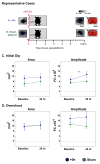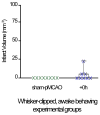Complete protection from impending stroke following permanent middle cerebral artery occlusion in awake, behaving rats
- PMID: 25216240
- PMCID: PMC4218886
- DOI: 10.1111/ejn.12723
Complete protection from impending stroke following permanent middle cerebral artery occlusion in awake, behaving rats
Abstract
Using a rodent model of ischemic stroke [permanent middle cerebral artery occlusion (pMCAO)], our laboratory has previously demonstrated that sensory-evoked cortical activation via mechanical single whisker stimulation treatment delivered under an anesthetized condition within 2 h of ischemic onset confers complete protection from impending infarct. There is a limited time window for this protection; rats that received the identical treatment at 3 h following ischemic onset lost neuronal function and sustained a substantial infarct. Rats in these studies, however, were anesthetized with sodium pentobarbital or isoflurane, whereas most human stroke patients are typically awake. To optimize our animal model, the present study examined, using functional imaging, histological, and behavioral analysis, whether self-induced sensorimotor stimulation is also protective in unrestrained, behaving rats that actively explore an enriched environment. Rats were revived from anesthesia either immediately or at 3 h after pMCAO, at which point they were allowed to freely explore an enriched environment. Rats that explored immediately after ischemic onset maintained normal cortical function and did not sustain infarct, even when their whiskers were clipped. Rats that were revived at 3 h post-pMCAO exhibited eliminated cortical function and sustained cortical infarct. Further, the data suggested that the level of individual active exploration could influence the outcome. Thus, early activation of the ischemic cortical area via unrestrained exploration resulted in protection from ischemic infarct, whereas late activation resulted in infarct, irrespective of the level of arousal or whisker-specific stimulation.
Keywords: animal models; ischemia; neuroprotection; plasticity; somatosensory cortex.
© 2014 Federation of European Neuroscience Societies and John Wiley & Sons Ltd.
Conflict of interest statement
The authors declare no potential conflicts of interest with respect to the research, authorship, and/or publication of this article
Figures
References
-
- Bland ST, Schallert T, Strong R, Aronowski J, Grotta JC, Feeney DM. Early exclusive use of the affected forelimb after moderate transient focal ischemia in rats: functional and anatomic outcome. Stroke. 2000;31:1144–1152. - PubMed
-
- Coyle P. Middle cerebral artery occlusion in the young rat. Stroke. 1982;13:855–859. - PubMed
Publication types
MeSH terms
Grants and funding
LinkOut - more resources
Full Text Sources
Other Literature Sources






